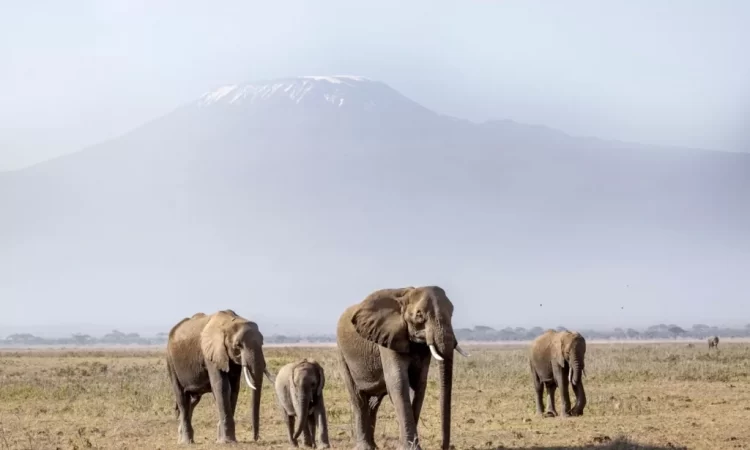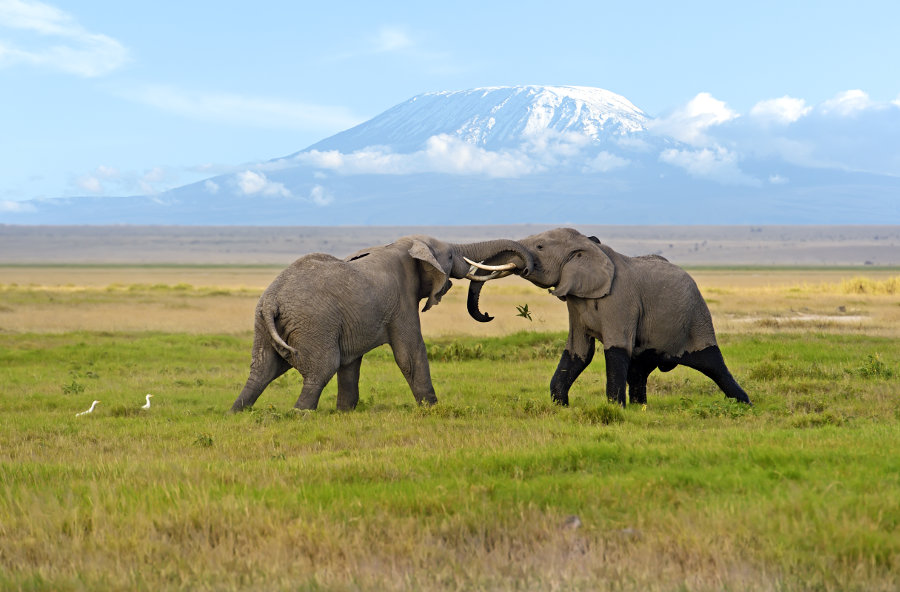Kenya’s Amboseli National Park also known as the “Land of Giants” is one of the most sought-after photographic safari and wildlife viewing destinations. Located at the feet of the tallest mountain in Africa, Mount Kilimanjaro, this park contains some of the most famous and beautiful sceneries in Africa. The park consists of open plains, swamps, and woodlands that allow for a great production of rich and diverse wildlife hence a good place to take photographs. Whether one is a beginner in photography or a professional, there is so much that one can capture of the African scenery at Amboseli National Park.

The Majestic Mount Kilimanjaro: A Perfect Backdrop
Another interesting and easily recognizable geographical characteristic of Amboseli National Park is being in the backdrop of Mount Kilimanjaro. Measuring 5,895 meters or 19,341 feet, Kilimanjaro is the tallest mountain in Africa and a symbol of the continent. The big and white-topped Kili makes a beautiful backdrop for the photography shots amidst the greenish savannah and the wild game in the park.
The early morning and late in the evening are the best time to take a picture of Mount Kilimanjaro since the light will clearly outline the features of the mountain and low clouds are likely to clear giving one a glimpse of the top part of the mountain. The park has positioned the rise of the mountain in contrast with the park’s grasslands with acacia trees and elephants that give a powerful and elegant touch to the park.
A Haven for Elephant Photography
Amboseli National Park’s famous livestock consists of large elephant herds commonly referred to as the ‘Amboseli elephants’. The elephants are perhaps some of the most photographed animal resources within the park because of their massive size and friendly disposition. A direct attraction for such elephants is the park’s swampland and marshlands that get water from melting snows on Kilimanjaro, particularly during the dry season.
Wildlife photographers can get an opportunity to take pictures of the elephants when they are swimming in the swamp or when they are in the process of wading through it, of how they socialize with each other and how they are able to get from one point to another across the vast savannah. This gives the feeling and intent that the play of light and shadow on the wrinkled skin of the elderly subjects, as well as other features of the textures of the surroundings, effectively translates into strong shots with Kilimanjaro as an effective backdrop.

Another highly-prized type of capture is the one that shows elephants moving on a single line with Mount Kilimanjaro in the background. This scene is perhaps one of the most typical scenes of Amboseli and is most definitely every wildlife photographer’s treasure.
Diverse Wildlife and Birdlife
Other animals found in Amboseli National Park are lions, cheetahs, zebras, giraffes, and buffaloes besides elephants. The park has also a variety of terrains ranging from plains to large savannah lands and woodlands these terrains offer a variety of subject matter for photography. Lions and cheetahs hunt for their prey or take a nap on the grass, and herds of zebras and giraffes continue to feed in front of Kili in the background.
If you are interested in watching birds then Amboseli is a veritable bird watchers’ delight. There are also over 400 types of birds such as flamingos, and pelicans up to the famous Fish eagle of Africa that is deemed as the symbol of freedom. It is, therefore, advisable to carry out bird photography especially when in the wetland and swampy areas that are home to water birds ranging from the elegant heron to the vibrant kingfisher.
Wildlife photographers desiring to photograph actions may do this by photographing the various associations in the wild, for example, a pride of lion hunting or a family of elephants playing. The park has diverse wildlife and ever-changing terrains, so there is always something interesting to capture on the camera.
Capturing the Unique Landscapes
As for natural surroundings, Amboseli’s territorial variety is as wide as its fauna. This vast land, overlaid with umbrella acacia trees, is ideal when it comes to creating a sense of the park’s identity, an identity of the African savannah. They also offer interesting scenery of swamps and wetlands that have a very different look from the dry planes as the greenness of the vegetation along with the reflection of the waters make a spectacular combination.
One of the attractions of the park is the fact that Lake Amboseli is a seasonal lake that forms during the rainy season but disappears in the other seasons leaving behind a setting that consists of saltpans and dusty planes. This changes the photographic prospects in the area as they are viewed at different times of the year. The dusty and cracked ground during dry seasons compounded by the movements of animals makes it<|reserved_special_token_257|>. optimizer, therefore, at a glance portrays a very dark and atmospheric scene.
There are other areas within the park that photographers can visit; the woodlands and the acacia forests which due to the variation in the light intensity gives a magician-like feel. The dawn and especially the dusk are golden hours as the colors and textures of the land are well captured due to the warm gentle light.
Tips for Photographers
To make the most of a photographic journey in Amboseli National Park, consider the following tips: To make the most of a photographic journey in Amboseli National Park, consider the following tips:
- Timing is Key: Among all types of light, it is recommended that photography is done during the morning and late in the evening. This is also the time when the animals are most likely to be active. It is recommended that you schedule your game drives at these times to get the best pictures.
- Bring the Right Equipment: Wildlife shots would require at least a 300mm zoom lens to take shots without disturbing the movement of the animals. It is also good for taking the wide expanses of Tanzania and the images associated with Mount Kilimanjaro.
- Be Patient: Wildlife photography are usually time-consuming. Patience is asked of the photographer with regard to the subjects, in order to get the best and most natural shots. This could result in even realistic and persuasive images.
- Respect Wildlife: It is recommended that there should always be a gap between the human populations and the animals. Self-explanatory; however, never try to get close to the animal and take the photograph or even if you have a zoom lens do not get close to the animal.
- Capture the Details: Forgetting small details is one common mistake people make that greatly affects their work. Focus on the details of an elephant, for instance, the rough texture of its skin, the stripes on the zebra, or the complexity of a bird’s plumage.
- Experiment with Angles: It is also good to work from different angles to bring diversity to your shots they are. Low shots often make the animals seem even more regal and high shots are useful in observing the terrain.
Conclusion
Kenya’s Amboseli National Park is a camera lover’s wonderland, for there are adequate opportunities through which one can make breathtaking images of the African beasts and terrains. Beautiful animals such as the elephants that are associated with the park, various animal species, and the natural beauty of the backdrop provided by Mount Kilimanjaro leave one feeling inspired. For working photographers, photojournalists, nature lovers or amateur and professional artists, the Amboseli scenery and diverse ecosystems will indeed provide a memorable as well as fruitful moment. When engaging in the tour, ensure you respect the features of Amboseli and respect the wildlife creatures throughout the widest.


